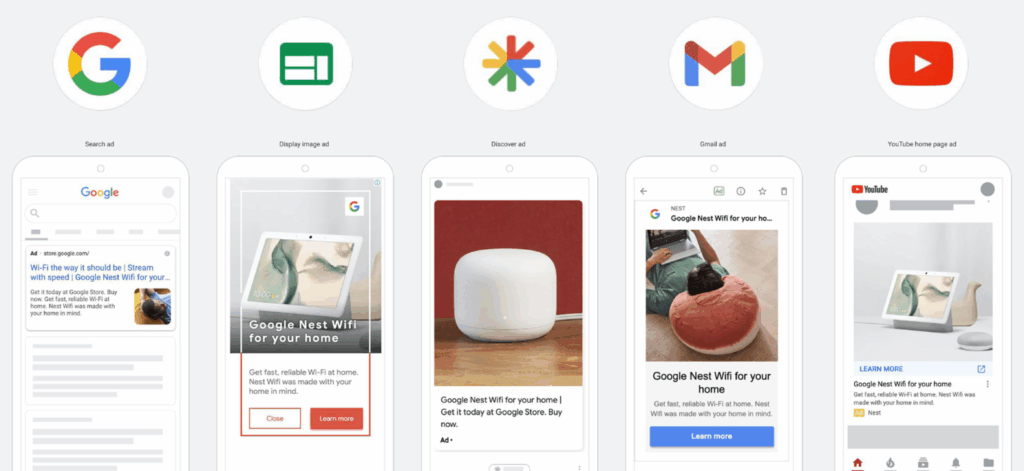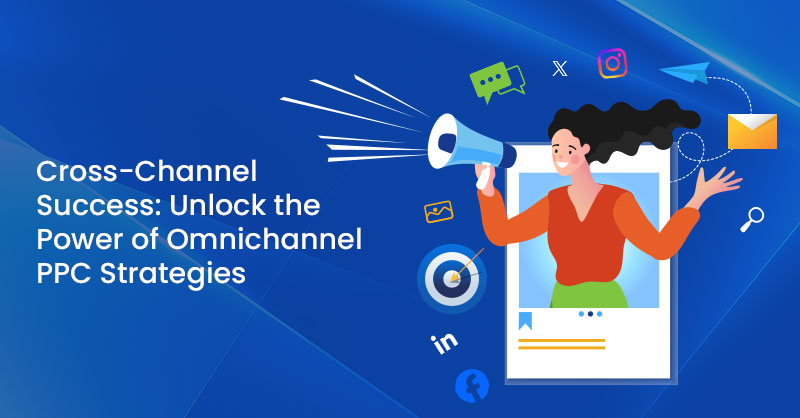This is where omnichannel PPC comes in. Think of it as weaving a single golden thread across multiple platforms: Google Ads, Meta Ads, LinkedIn Ads, and even reward apps and television hashtags. This is designed to make the customer’s purchase journey feel natural and continuous.
Google has called these intent-rich moments Micro Moments, or Macromoments, when people instinctively grab their device to act. They search, compare, or buy in seconds. If you are not present in these moments, you miss the chance to shape the decision. Omnichannel PPC ensures you are there, visible and relevant when it matters most.
Unlike campaigns locked into one channel, omnichannel PPC maintains continuity. A person might discover you through a search, see your ad on their favourite social media platform later that evening, and then encounter a personalized message in their inbox the next day. If marketers reach customers through three or more integrated channels, order rates can be nearly five times higher than single-channel campaigns.
It’s not repetition; it’s resonance. This is why omnichannel PPC is becoming increasingly essential for enhancing engagement, ensuring consistency, and maximizing return on ad spend.
What Is Omnichannel Marketing?
Omnichannel marketing is about creating one experience that flows seamlessly across platforms. It’s not enough to simply show up everywhere. Multichannel marketing does that, but it often feels disjointed. Omnichannel brings harmony.
It’s the difference between hearing random instruments warming up and listening to a symphony. Each channel plays its part, but together they carry the same melody. Whether someone encounters you on search, in an app, or in a store, the experience feels unified, familiar, and intentional.
Source: Optimine
How Is Omnichannel PPC Different from Traditional PPC?
Traditional PPC campaigns live in silos. A Google Ads campaign might work in isolation, but it cannot extend the conversation if the customer later spends time on LinkedIn or Instagram. The message is confined, and the momentum often stops there.
Omnichannel PPC, by contrast, is like mapping constellations in the night sky. Each platform glimmers on its own, but together they create a clearer picture. The magic lies in real-time data integration, customer journey mapping and crafting a narrative that unfolds across each touchpoint.
Benefits of Omnichannel PPC Strategies
Enhanced Customer Engagement Across Platforms
People do not live on one platform, so your campaigns should not either. Omnichannel PPC keeps the conversation alive, whether your audience is searching on Google in the morning, scrolling through Meta at lunch, or networking on LinkedIn in the evening.
Optimize Communications for Maximum Brand Attention
Attention is fleeting, but consistency helps capture it. When your visuals, tone, and offers are unified across channels, customers begin to recognize and trust your presence. That recognition turns into attention, and attention often becomes action.
Consistent Branding and Unified Messaging
Trust is built through familiarity. When your branding feels consistent across every touchpoint, including search, social media, apps, and email, customers don’t question who you are. They know. That recognition gives them the confidence to take action.
Improved Budget Optimization and ROI
Omnichannel PPC allows you to be nimble. By comparing results across channels, you can allocate spend where it drives the most value. This fluid approach means no wasted dollars and a stronger return on investment. Brands using more than two channels see, on average 9% higher sales revenue growth, and omnichannel businesses often grow nearly three times faster than those without integrated strategies
Better Audience Segmentation and Targeted Content
Data tells stories if you know how to listen. By unifying insights from CRM platforms, analytics, and campaign performance, you can create sharper segments and serve content that feels personal. Data tells a story when you listen. Brands delivering personalization based on customer actions saw a 20% increase in customer satisfaction, and using first-party data for omnichannel strategies can drive 40% more revenue.
Increased Conversions Through Ads Retargeting
Retargeting across platforms is like gently reminding someone of a conversation you were already having. A cart left behind on the desktop might trigger a reminder on social media later that day. Customers exposed to ads on multiple platforms report higher purchase intent and recall, boosting conversions. Campaigns spanning three or more channels deliver up to 494% higher order rates.
Unified Tracking for Accurate Key Performance Indicators
Without integration, metrics are fragments. Omnichannel PPC brings clarity by connecting touchpoints, allowing you to see the whole picture. That clarity allows for smarter decisions and more accurate measurements of success.
How to Build an Effective Omnichannel PPC Strategy
Define Buyer Personas for Targeted Ads
Every strong strategy begins with understanding who you are speaking to. Buyer personas are more than demographic. They are windows into behaviour, motivation, and preference. They help ensure your ads are not just seen, but felt.
Leverage CRM Platforms for Data-Driven Decisions
CRM platforms hold the raw material for personalization. When integrated with PPC campaigns, they allow you to adjust messaging based on loyalty status, purchase history, or customer lifecycle stage. This is where campaigns begin to feel almost magical.
Use A/B Testing to Optimize Ad Performance
Testing is the craft of the Sage. It’s the practice of asking questions and letting the data provide answers. A/B testing across creatives and placements ensures your decisions are guided by evidence, not assumptions.
Align Google Ads, Meta Ads, and LinkedIn Ads for Maximum Reach
Each platform touches a different part of the customer journey. Google captures intent, Meta captures lifestyle, LinkedIn captures professional context. Together, they form a complete story. Aligning them amplifies your reach.
Personalize Messaging for Higher Engagement
Generic ads fall flat. Personalization turns ads into conversations. By tailoring messaging based on real behaviour, you create moments where the customer feels seen, and that feeling drives engagement. 67% of shoppers expect brands to understand them based on past interactions.
Incorporate Television Hashtags to Expand Reach
Television and digital no longer live in separate worlds. Television hashtags encourage audiences to transition from broadcast to search or social media. When paired with PPC, they expand reach and deepen engagement.
Implement Reward Apps to Boost Customer Retention
Loyalty isn’t built in a single transaction. Reward apps reinforce relationships by offering incentives that encourage repeat engagement. When PPC highlights these rewards, retention becomes a natural outcome.
Examples of Successful Omnichannel PPC Campaign
REI
REI combines digital ads, social campaigns, and in-store experiences into one journey. A customer might discover gear through search ads, be inspired by social storytelling, and complete their purchase in store, all within a consistent brand narrative.
Amazon
Amazon is a master of retargeting. A product viewed online can reappear in ads across Google, Meta, and even within the Amazon app. By unifying data, Amazon creates a constant loop of reminders that gently guide customers toward conversion.
Nike
Nike blends ads, social engagement, and influencer content to create momentum around product launches. Their campaigns feel immersive, carrying the same branding across every touchpoint, from Google Ads to reward app promotions.
Starbucks
Starbucks connects its rewards app with PPC campaigns, offering targeted promotions that reflect individual purchase histories. Whether you are on mobile, in store, or scrolling through social, the offers feel tailored.
Airbnb
Airbnb unifies its search, display, and social ads into one seamless journey. Behavioural data informs which message appears where, ensuring the experience feels consistent from the first search to the final booking.
Trends in Omnichannel Marketing for 2025
AI-Powered Ads Retargeting for Smarter Campaigns
Artificial intelligence is refining retargeting. By predicting who is most likely to convert, AI ensures ads appear at the right time with the right message, increasing efficiency and impact.
Google’s Performance Max campaigns demonstrate this shift by utilizing machine learning to optimize creative, targeting, and budget across all Google properties—Search, YouTube, Display, Gmail, and Maps—while ensuring consistent messaging in critical micro-moments. Meta’s Advantage+ campaigns take a similar approach within the social ecosystem, automating audience discovery and creative testing to serve the right content to the right people.

Source: Marin Software
Together, these tools demonstrate how AI can eliminate the friction of manual management, enabling marketers to focus on strategy while algorithms deliver relevance, consistency, and performance across channels.
Voice Search and PPC – Optimizing for a Hands-Free Future
The way people search is changing. By 2025, over half of online searches are expected to be voice-based, and this shift is transforming how ads are planned. Instead of typing short phrases like “best coffee near me,” people speak in full sentences: “Where can I get the best latte near me right now?”
This means that natural language (not just keywords) is at the centre of future PPC strategy. For advertisers, it requires building campaigns around conversational queries, long-tail keywords, and even question-based phrasing. Google Ads and Microsoft Ads are already adapting their algorithms to better match these intent-rich, spoken searches.
The Role of Influencer Partnerships in PPC Campaigns
Influencers provide authenticity, and when paired with PPC, their reach multiplies. This blend of human connection and targeted advertising is becoming a powerful force.
Interactive and Shoppable Ads for Higher Conversions
Customers no longer want passive ads. They want to interact and act instantly. Interactive formats, such as swipeable carousels, polls, and video demos, pull users deeper into the journey. Shoppable ads take it a step further by allowing people to make purchases directly within the ad, thereby removing friction and boosting conversions.
Brands using these formats have seen engagement rise by 40% or more, with conversion rates often outpacing static ads. By integrating ads into the shopping experience, marketers transform them from interruptions into opportunities.
Automation in Budget Optimization and Ad Placement
Automation is giving marketers more freedom to focus on strategy. Smart bidding and AI-powered placements ensure that budgets flow to where they create the most value.
Conclusion
Omnichannel PPC isn’t just a strategy; it’s the future of meaningful digital marketing. By integrating platforms, unifying data, and personalizing messaging, brands create experiences that feel less like campaigns and more like conversations.
When every touchpoint tells the same story, customers feel understood. That understanding builds engagement, drives conversions, and strengthens loyalty.
At TechWyse, we view omnichannel PPC as both a wisdom and a transformation. The wisdom lies in understanding the data and aligning strategies. The transformation lies in creating experiences that feel seamless, human, and even a little magical. The brands that embrace this approach will not just compete, they will lead.
Ready to elevate your digital marketing strategy with omnichannel PPC? Reach out to TechWyse and build a strategy that amplifies your brand’s presence and drives real results! Call 866-208-3095 or contact us here.

